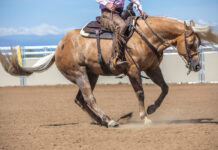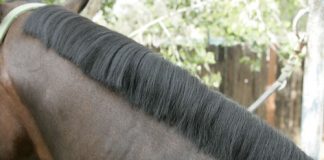When APHA judge and educator David Denniston of Mead, Colo., isn’t judging horse shows, he’s busy developing horse show patterns for other judges and exhibitors. Here, he provides step-by-step advice on how to ride one of his horsemanship patterns.

The pattern starts with the rider being ready at marker A and departing directly to the left lead lope. The rider must maintain good position through the departure and must not get too far in front of or behind the horse through the transition. The rider who gets in front of the horse will tend to lean forward, while the rider who is left behind will end up leaning back or with shoulders thrown back.
 Click to Enlarge |
The rider must then anticipate and plan for the downward transition to the walk from marker B to marker C. A downward transition from the lope to the walk is a great test of a rider’s seat, and the rider must maintain a strong seat in the saddle while maintaining overall position.
Then, the pattern calls for another lope departure to marker D followed by a slight increase in speed and a large circle to the right at D. In Denniston’s advanced horsemanship patterns, he likes to include an increase in speed because it gives the rider the opportunity to show some courage and really demonstrate what he can do with his horse. Skilled riders aren’t afraid to move their horse forward to demonstrate how good of a rider they truly are and how strong their seat is. The weaker riders are more conservative and have a difficult time sticking to the saddle in a pattern requiring an increase in speed. The upward transition to the faster lope should be done at the marker. While circling, the rider should never lose any control.
The rider then must transition back to the small slow circle to the right, demonstrating complete control of the horse through the transition.
Next, the rider should effect a balanced and square stop at marker D, again maintaining proper position through the downward transition.
The pivot should be performed quietly and on the inside hind leg. Denniston likes to see a pivot that is prompt and smooth, and doesn’t like to see a rider who sacrifices correctness for speed.
The transition out of the pivot and directly into the extended jog should be performed with confidence and courage. Extended jogs are another great test; the strong riders will be steady in their seat and upper body and won’t be afraid to challenge the pattern.
The stop at marker B and back to marker C should be responsive and quiet.
Overall, this pattern includes several challenging elements and is a great test for the more advanced rider. The best thing about this pattern is that it contains just the right number of advanced maneuvers, so great riders will rise to the top and really shine.
For additional patterns, visit Dave Denniston’s website at www.horseshowpatterns.com.
Liked this article? Here are others you’ll love:
Tips for Winning in Horsemanship
Horsemanship Topiclist






very helpful